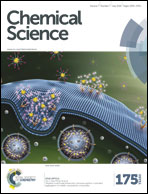Stable end-sealed DNA as robust nano-rulers for in vivo single-molecule fluorescence†
Abstract
Single-molecule fluorescence and Förster resonance energy transfer (smFRET) are important tools for studying molecular heterogeneity, cellular organization, and protein structure in living cells. However, in vivo smFRET studies are still very challenging, and a standardized approach for robust in vivo smFRET measurements is still missing. Here, we synthesized protected DNAs with chemically linked ends as robust in vivo nano-rulers. We efficiently internalized doubly-labeled end-sealed DNA standards into live bacteria using electroporation and obtained stable and long-lasting smFRET signatures. Single-molecule fluorescence signals could be extended to ∼1 min by studying multi-fluorophore DNA standards. The high stability of protected DNA standards offers a general approach to evaluate single-molecule fluorescence and FRET signals, autofluorescence background, and fluorophore density, and hence, quality check the workflow for studying single-molecule trajectories and conformational dynamics of biomolecules in vivo.



 Please wait while we load your content...
Please wait while we load your content...